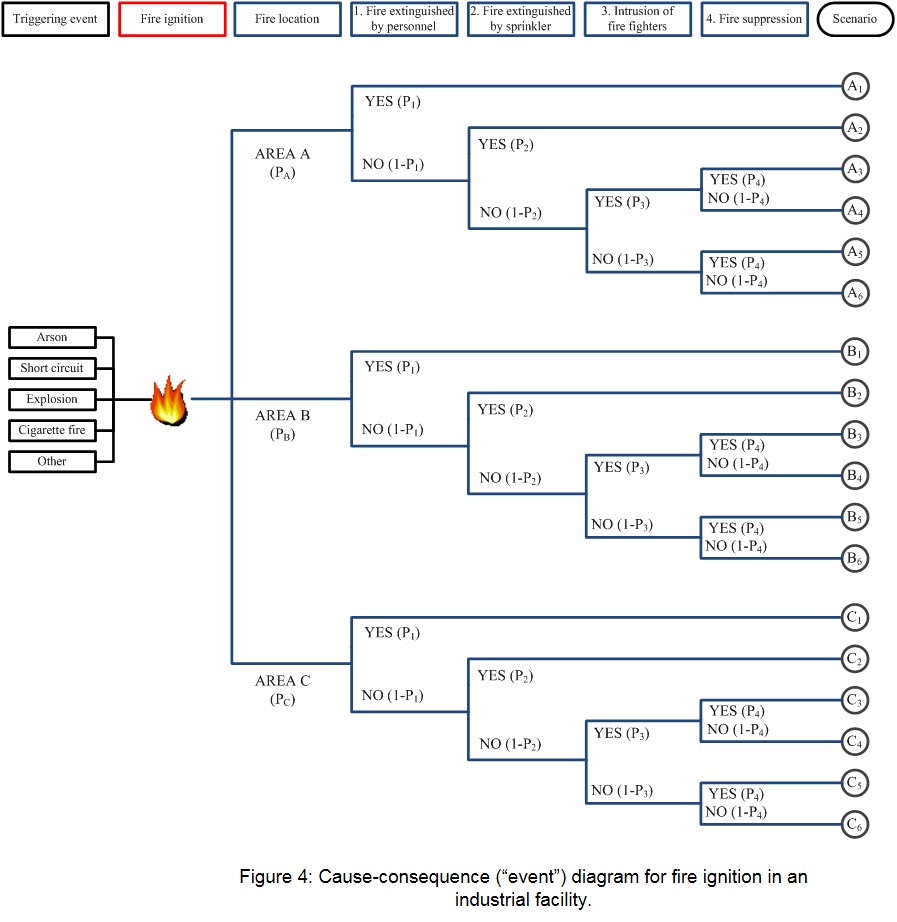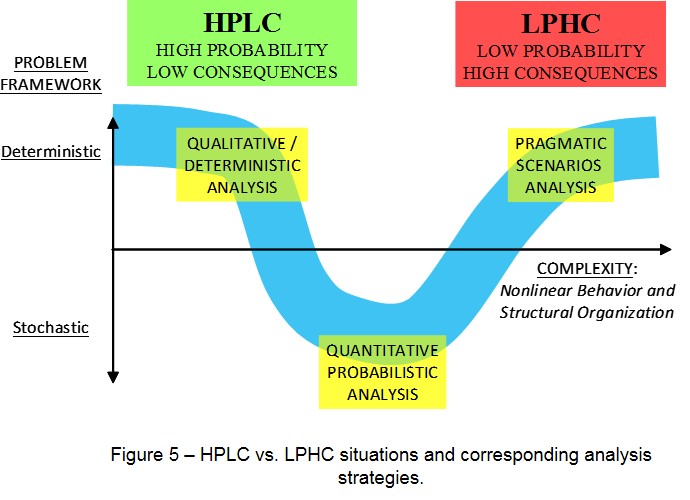Different approaches to FHA and LPHC events
Different approaches can be followed in fire hazard characterization: deterministic, heuristic/semi-probabilistic (scenario-based), and (not-yet completely developed in literature) fully probabilistic.
Traditionally, the fire design of structures can be conducted in deterministic terms, meaning that a single worst-case fire is considered and selected in FHA for each fire compartment in the considered environment, and it is defined on the basis of “expert” judgement.
Real attention to modern this approach for FHA (aiming at establishing some likelihood or “occurrence” of different fire severities) started come up on 90s, when the definition of fire “scenario” started to be used in structural design, including room/compartment dimensions, contents, arrangement of room in the structure/building, source of combustion air (windows, doors, etc.), building/structure’s users location. Then, a more detailed FHA can be conducted by an heuristic approach, meaning that a set of “fire scenarios” are defined by the designer on the basis of the specific features of the problem and a likelihood is someway assigned to the scenarios. The following key aspects need to be addressed in heuristic FHA:
- - identification of a comprehensive set of possible fire scenarios;
- - estimation of probability of occurrence of the scenario;
two above points imply the ranking of fire scenarios by severity and probability, the inquiry of operational constraints and a list of recommended actions to eliminate or control the hazard. The advantage of this approach is that an inventory of possible fire scenarios can be easily generated. On the downside, some scenarios can be missed, thus it is not easy to have an insight into overall risk associated with the system. A method of group examination to identify hazards and their consequences is the so-called Hazard and operability study (HAZOP), where comprehensive number of possible fire initiative hazards is given (SFPE 2005), and include:
- - cigarettes or other smoking materials (e.g., lighters, matches);
- - torch, hot work, or other open flame devices;
- - heating, refrigeration, and air conditioning equipment;
- - cooking equipment;
- - tools and appliances;
- - process or service equipment, including separate motors or internal combustion engines;
- - electrical distribution equipment (e.g., wiring, switches, outlets, cords and plugs, light fixtures, transformers);
- - hot objects, most of which also fall into one of the above categories, such as a light bulb or the heating surface of heating equipment;
- - vulnerability to lightning or static electricity;
- - chemicals capable of spontaneous heating;
- - wildfire or other exterior exposure fire.
The above are direct hazards, in the sense that constitute heat sources themselves. Other events, natural or not, may constitute as well (indirect) fire initiating fires, since they have the potential to create a heat sources (e.g. lighting, earthquake, floods, impacts), alone or in combination with the specific conditions (e.g. the presence of pipe work carrying flammable liquids or gases). The choice of important fire scenarios for the case studied is focused on three areas that, after an initial evaluation, seem to produce the most adverse fire scenarios. The identified most severe areas for the fire ignition and their features in terms of ventilation, presence of combustible material and fire ignition factors (listed above), give birth to a number of scenarios. When the fire risk prone areas are identified, an event tree (NFPA 2017, Haines 1998) representing the evolution of the triggering event has to be developed for each scenario (Figure 4). Here three areas are assumed for a generic building facility for illustration purposes: the central zone of the building (Area A), a secondary zone of the building (Area B), he outer zone (Area C). The event tree is further divided to take account for more than one initial situations. The one presented here, is relevant to a condition where the doors of the facility are closed, yet there are employees inside. In the generic event tree of Figure 4 (as already said, it is shown here for illustration purposes), the consequences of an initiative event are followed in a series of possible paths.

The analysis can be quantified by assigning numerical values to the probabilities as shown for example in Table 1, in the case of a triggering event in area B.
Table 1: Probabilities for the occurrence of different scenarios.
|
SCENARIO |
PROBABILITY |
|
B1 |
PB*P1 |
|
B2 |
PB*(1-P1) *P2 |
|
B3 |
PB*(1-P1) *(1-P2)*P3*P4 |
|
B4 |
PB*(1-P1) *(1-P2)*P3*(1-P4) |
|
B5 |
PB*(1-P1) *(1-P2)*(1-P3)*P4 |
|
B6 |
PB*(1-P1) *(1-P2)*(1-P3)*(1-P4) |
The shown probabilities are intended as in function of time, that is, P = P (t). In this sense, P4 may not the same after condition 3 (intrusion of the fire fighters), since the expansion of the fire is different for the two cases. For the same reason, probabilities of the various branches are different for the 3 different areas (e.g. the probability P2 of the fire being extinguished by the sprinklers, is different for each one of the Areas, since the sprinkler arrangement is different in each area).
Finally, regarding fully probabilistic models (Stewart and Melchers 1997), it must be said that, at the contrary of Earthquake Engineering, at the present date for FHA they are not yet completely developed in literature. This is due to two main reasons, still hiring the use of fully probabilistic analysis in fire engineering:
- - first of all (Lange et al. 2014), there are relevant differences between the two hazards (earthquake and fire). In fact for earthquake engineering as opposed to fire engineering, a number of independent records of earthquake events exists different regions, something that is facilitated by the independence of the earthquake and the corresponding ground motion from the structure – the variables which are of interest in determining the ground motion intensity may be limited to only the distance from the fault line of the facility and the soil/ground conditions at the site. Conversely, the evolution of a fire in a structure is (as already said) strictly dependent upon the features of the compartment;
- - second issue related to the application of fully probabilistic approaches in fire engineering is more relevant than the previous one. In cases (like fires on structures) where the hazard is not natural but, on the contrary, it is connected with human activity, and where the consequences can be extreme (e.g. collapses, loss of life), the analysis and management of the problem is matter for the so-called “complex system theory” (Randall 2011, Bier 1997). Beside the structural one, others component of the overall problem complexity arising in structural performances evaluation under fire are given by: i) the difficulties arising in characterizing the fire IM from a probabilistic point of view (see above); ii) the needs of exploring extreme structural behaviours (e.g. progressive collapses or extremely damaged configurations or sudden changes of structural configuration). The two components listed above are typical of those events that, due to both the possible induced structural collapse and their low occurrence, are called “Low Probability and High Consequence (LPHC)” events (Perrow 1984, Ellingwood, 2009, Starrosek 2009). These situations arise for a lot of different and multifaceted reasons, being possibly followed by catastrophic consequences and it’s almost impossible to frame them inside any well-recognized probabilistic format. Opposite to the LPHC events, there are the ordinary hazard scenarios (e.g. low intensity earthquakes or winds) which are called “High Probability and Low Consequence (HPLC)” events. Of course, problem complexity increases passing from HPLC to LPHC events. This appears clear when one thinks that, by definition, HPLC events are frequently observed (and then statistically describable), being LPHC events only rarely experienced and, above all, more variable in nature. As shown in Figure 5, one can adopt two different frameworks to solve the problem: i) a deterministic approach; ii) a stochastic approach. It means that with the first approach one fixes all the aspects of the problem in a definite way, while with the second approach one allows some stochastics to enter in the description. Now, one recognizes essentially three regions: a) the first one is a region connected with low complexity, i.e. evolutive designs or HPLC events, where even direct qualitative analysis finds place; usually, here, true deterministic analysis are conducted; b) the second region is found where the complexity of the problem has grown and aspects of the problem can be usefully considered adding stochastics in the formulation; c) finally, it appears that as the complexity of the problem has reached some critical size, the only way to face and to solve the problem is turning back to some ad-hoc deterministic approach; it means that, with an act of force, the problem is posed and solved by the so-called heuristic way of thinking.
Then at the present stage, the more reliable approach to FHA is the semi-probabilistic scenario-based one described above.



